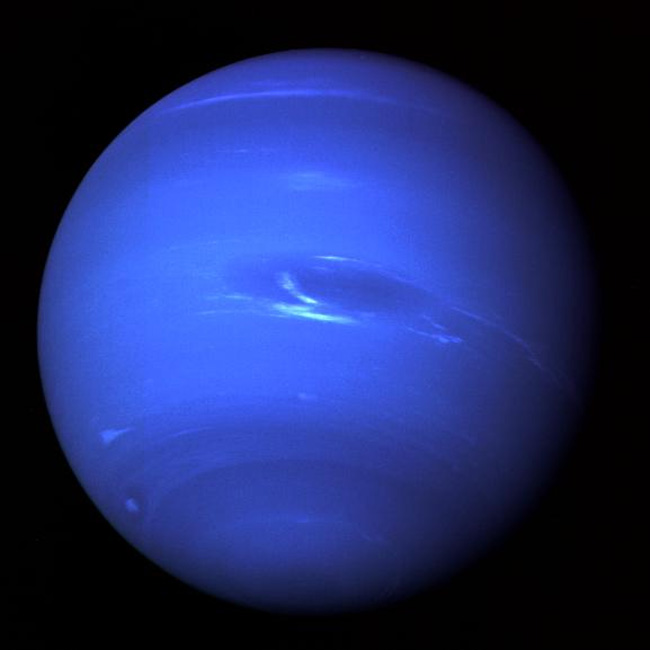
Neptune is much too faint to be seen with the unaided eye, but right now you can see the blue planet shine just by using binoculars.
Neptune lies an average distance of 2.8 billion miles (4.5 billion km) from the sun. With the demotion of Pluto to dwarf planet status, Neptune is now the farthest of the "classical" planets in the solar system. It is slightly smaller than Uranus, with a diameter of 30,775 miles (49,528 km).
Currently at magnitude +7.8, it's more than six times dimmer than Uranus. Nonetheless, if you have access to a dark, clear sky and carefully examine a good star map, y ou should have no trouble in finding it with binoculars. Neptune can be found among the stars of Aquarius which is about one-third of the way up from the southeast horizon to the point directly overhead (called the zenith) as darkness falls. [Photos of Neptune, The Mysterious Blue Planet]
With a telescope, trying to resolve Neptune into a disk will be more difficult than it is with Uranus. You're going to need at least a 4 inch (10 centimeters) telescope with a magnification of no less than 200-power, just to turn Neptune into a tiny blue dot of light.
A turbulent ringed world
Voyager 2 passed Neptune in 1989, revealing a deep-blue atmosphere with rapidly moving wisps of white clouds.
Also evident was a Great Dark Spot, rather similar to Jupiter's famous Great Red Spot. Using the Hubble Space Telescope, the original Dark Spot seen by Voyager 2 has dissipated; yet apparently was replaced by another.
Get the Space.com Newsletter
Breaking space news, the latest updates on rocket launches, skywatching events and more!
Neptune's atmosphere is composed chiefly of hydrocarbon compounds. Voyager 2 also revealed the existence of at least three rings of very fine particles around Neptune.
At last count, Neptune plays host to 14 moons, one of which, Triton has a tenuous atmosphere of nitrogen and is larger than Pluto at nearly 1,700 miles (2,736 km) in diameter. Because Neptune moves in a retrograde (backward) orbit, some scientists have suggested that Neptune may actually have captured Triton in the distant past. Those who have access to a telescope of 12 inches (30 cm) or more might even be able to get a glimpse of Triton, very close to Neptune itself.
The race to find Neptune
Neptune's was discovered after long-term observations of Uranus. Astronomers theorized that some unknown body was somehow perturbing Uranus' orbit.
In 1846, two astronomers, Urbain J.J. Leverrier (1811-1877) of France and John Couch Adams (1819-1892) of England independently were working on this problem. Neither knew what the other was doing, but ultimately, both men had figured out the probable path of the supposed object that was disturbing the orbit of Uranus.
Both believed that the unseen body was then in the constellation of Aquarius, the Water Bearer. Adams was a student at Cambridge University, England and he sent his results to Sir George Airy (1801-1892), the Astronomer Royal, with specific instructions on where to look for it.
For some unknown reason Airy delayed a year before starting the search. In the meantime, Leverrier wrote to the Berlin Observatory requesting that they search in the place his directed. Johann Galle and Heinrich d'Arrest at Berlin did exactly as instructed and found the new planet in less than an hour.
In July 2011 Neptune completed one full trip around the sun since its discovery in 1846.
Galileo almost found it
Neptune was very nearly discovered by none other than the renowned Italian astronomer Galileo Galilei with his crude telescope more than 2.5 centuries earlier. Galileo unknowingly recorded Neptune as an eighth magnitude star while observing Jupiter and its system of four large satellites on December 28, 1612.
Just over one month later, on January 27, 1613, Galileo recorded two stars in his telescope field, one of which was Neptune. The next night when he looked again, he noted that the two stars seemed further apart. If he had only continued to keep watch in the following nights he would have almost certainly would have realized that one of the "stars" was indeed moving.
Like Galileo, later observers stumbled across Neptune without realizing its true nature. Among them was the skilled French astronomer, Lalande (1795); the English astronomer, John Herschel (1830); and the Scottish astronomer, Von Lamont, just days before Neptune was actually discovered in 1846. All thought it was nothing more than an ordinary star.
Joe Rao serves as an instructor and guest lecturer at New York's Hayden Planetarium. He writes about astronomy for Natural History magazine, the Farmer's Almanac and other publications, and he is also an on-camera meteorologist for News 12 Westchester, N.Y. Follow us @Spacedotcom, Facebook and Google+. Original article on SPACE.com.
Join our Space Forums to keep talking space on the latest missions, night sky and more! And if you have a news tip, correction or comment, let us know at: community@space.com.

Joe Rao is Space.com's skywatching columnist, as well as a veteran meteorologist and eclipse chaser who also serves as an instructor and guest lecturer at New York's Hayden Planetarium. He writes about astronomy for Natural History magazine, Sky & Telescope and other publications. Joe is an 8-time Emmy-nominated meteorologist who served the Putnam Valley region of New York for over 21 years. You can find him on Twitter and YouTube tracking lunar and solar eclipses, meteor showers and more. To find out Joe's latest project, visit him on Twitter.









